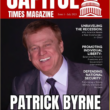Greetings, and peace. As we Irish say, “I’m sorry for your troubles.”
In today’s Salt Lake Tribune there is a story that is 100% correct: two years ago an elder statesman of the hedge fund industry sat me down to tell me that I had become the most hated man in living memory in New York, that you folks despise me utterly, and so on. All true, I’m sure. So it goes.
However, from examining the logs I also know that thousands of people from major Wall Street institutions have visited this site and are passing these pieces around. I was planning on writing an open message to you in the 2007 holiday season, or the 2008, yet while I have learned that I have but little influence over this course of events, I have even less over its pace. Now it is August, and the time to write has arrived.
I have said harsh things about Wall Street. Harsh words have been said about me as well. Let’s get past that for a moment. Instead, I have a story to share before we return to our battle.
Richard Feynman, one of the greatest physicists of the 20th century, sat in a drum circle telling stories that were compiled into the book Surely You’re Joking, My. Feynman (which can be conveniently purchased at a discount site I know). Some stories came from his days as a 24 year-old quant working on the Manhattan Project. One concerns the time he was sent to review plans for the factory in Oak Ridge, Tennessee, where the uranium for the atomic bomb would be purified. I will quote from it at length, both for its charm and, also, because it says something about the battle into which you folks and I seem to be locked.
=============================================================
Some of the special problems I had at Los Alamos were rather interesting. One thing had to do with the safety of the plant at Oak Ridge, Tennessee. Los Alamos was going to make the bomb, but at Oak Ridge they were trying to separate the isotopes of uranium — uranium 238 and uranium 235, the explosive one. They were just beginning to get infinitesimal amounts from an experimental thing of 235, and at the same time they were practicing the chemistry. There was going to be a big plant, they were going to have vats of the stuff, and then they were going to take the purified stuff and repurify and get it ready for the next stage. (You have to purify it in several stages.) So they were practicing on the one hand, and they were just getting a little bit of U235 from one of the pieces of apparatus experimentally on the other hand. And they were trying to learn how to assay it, to determine how much uranium 235 there is in it. Though we would send them instructions, they never got it right.
So finally Emil Segre said that the only possible way to get it right was for him to go down there and see what they were doing. The army people said, “No, it is our policy to keep all the information of Los Alamos at one place.”
The people in Oak Ridge didn’t know anything about what it was to be used for; they just knew what they were trying to do. I mean the higher people knew they were separating uranium, but they didn’t know how powerful the bomb was, or exactly how it worked or anything. The people underneath didn’t know at all what they were doing. And the army wanted to keep it that way. There was no information going back and forth. But Segre insisted they’d never get the assays right, and the whole thing would go up in smoke. So he finally went down to see what they were doing, and as he was walking through he saw them wheeling a tank carboy of water, green water — which is uranium nitrate solution.
He said, “Uh, you’re going to handle it like that when it’s purified too? Is that what you’re going to do?”
They said, “Sure — why not?”
“Won’t it explode?” he said.
Huh! Explode?
Then the army said, “You see! We shouldn’t have let any information get to them! Now they are all upset.”
It turned out that the army had realized how much stuff we needed to make a bomb — twenty kilograms or whatever it was — and they realized that this much material, purified, would never be in the plant, so there was no danger. But they did not know that the neutrons were enormously more effective when they are slowed down in water. In water it takes less than a tenth — no, a hundredth — as much material to make a reaction that makes radioactivity. It kills people around and so on. It was very dangerous, and they had not paid any attention to the safety at all.
So a telegram goes from Oppenheimer to Segre: “Go through the entire plant. Notice where all the concentrations are supposed to be, with the process as they designed it. We will calculate in the meantime how much material can come together before there’s an explosion.”
Two groups started working on it. Christy’s group worked on water solutions and my group worked on dry powder in boxes. We calculated about how much material they could accumulate safely. And Christy was going to go down and tell them all at Oak Ridge what the situation was, because this whole thing is broken down and we have to go down and tell them now. So I happily gave all my numbers to Christy and said, you have all the stuff, so go. Christy got pneumonia; I had to go….
At any rate, I arrived at Oak Ridge. The first thing I did was have them take me to the plant, and I said nothing. I just looked at everything. I found out that the situation was even worse than Segre reported, because he noticed certain boxes in big lots in a room, but he didn’t notice a lot of boxes in another room on the other side of the same wall — and things like that. Now, if you have too much stuff together, it goes up, you see.
So I went through the entire plant. I have a very bad memory, but when I work intensively I have a good short-term memory, and so I could remember all kinds of crazy things like building 90-207, vat number so-and-so, and so forth.
I went to my room that night, and went through the whole thing, explained where all the dangers were, and what you would have to do to fix this. It’s rather easy. You put cadmium in solutions to absorb the neutrons in the water, and you separate the boxes so they are not too dense, according to certain rules.
The next day there was going to be a big meeting. I forgot to say that before I left Los Alamos Oppenheimer said to me, “Now, the following people are technically able down there at Oak Ridge: Mr. Julian Webb, Mr. So-and-so, and so on. I want you to make sure that these people are at the meeting, that you tell them how the thing can be made safe, so that they really understand.”
I said, “What if they’re not at the meeting? What am I supposed to do?”
He said, “Then you should say: Los Alamos cannot accept the responsibility for the safety of the Oak Ridge plant unless…!”
I said, “You mean me, little Richard, is going to go in there and say –?”
He said, “Yes, little Richard, you go and do that.”
I really grew up fast!
When I arrived, sure enough, the big shots in the company and the technical people that I wanted were there, and the generals and everyone who was interested in this very serious problem. That was good because the plant would have blown up if nobody had paid attention to this problem.
There was a Lieutenant Zumwalt who took care of me. He told me that the colonel said I shouldn’t tell them how the neutrons work and all the details because we want to keep things separate, so just tell them what to do to keep it safe.
I said, “In my opinion it is impossible for them to obey a bunch of rules unless they understand how it works. It’s my opinion that it’s only going to work if I tell them, and Los Alamos cannot accept the responsibility for the safety of the Oak Ridge plant unless they are fully informed as to how it works!”
It was great. The lieutenant takes me to the colonel and repeats my remark. The colonel says, “Just five minutes,” and then he goes to the window and he stops and thinks. That’s what they’re very good at — making decisions. I thought it was very remarkable how a problem of whether or not information as to how the bomb works should be in the Oak Ridge plant had to be decided and could be decided in five minutes. So I have a great deal of respect for these military guys, because I never can decide anything very important in any length of time at all.
In five minutes he said, “All right, Mr. Feynman, go ahead.”
I sat down and I told them all about neutrons, how they worked, da da, ta ta ta, there are too many neutrons together, you’ve got to keep the material apart, cadmium absorbs, and slow neutrons are more effective than fast neutrons, and yak yak — all of which was elementary stuff at Los Alamos, but they had never heard of any of it….
========================================================
Richard Feynman was not only one of the greatest scientific minds of the 20th century, he was also hilarious, and I encourage you to read his book. I include this Las Alamos story here for the resemblance it bears to our battle over “naked short selling”. I am not claiming to be smarter or more moral than any of you folks. I do believe, however, that you have a problem in your “factory” (the nation’s stock settlement system) of which you are unaware. That problem is the systemic risk created by unsettled trades. Like the U-235 in Feynman’s story, this is dangerous, and from my point of view, it looks like you folks have not paid much attention to the safety question. We of the Market Reform Movement worry about “how much material can come together before there’s an explosion.”
I will assume that all Wall Street readers understand why an unsettled trade is a derivative, and specifically, a Contract For Difference (“CFD”). You know also that the value of a derivative is a function of some underlying event (that’s what makes it “a derivative”). Unsettled equity trades seem to me unusual in their ability to affect the underlying events of which their values are derivative. Florida orange farmers wanting to hedge their risk can buy all the derivative contracts on sunshine in Florida that they want, but it will not affect the amount of sunshine in Florida. Similarly, Credit Default Swaps do not affect the rates of third party defaults (in any immediate sense, anyway). But from the SEC’s recent Emergency Order it would appear that the SEC, the 19 financial institutions now enjoying special protection, and 8,500 banks clamoring for the same treatment, have come to recognize naked short selling can affect share prices.
This is not to say that naked short selling always affects the underlying event (one could naked short Berkshire Hathaway all day long and it would not affect its share price), nor is it to say that unsettled equity trades are the only derivatives with this ability (various debt-related derivatives may be another, in the long run). However, if one considers naked shorting in small and mid-size stocks, one sees that it is a derivative that affects the underlying events immediately and directly.
So if the underlying event drives the value of the derivative, and this derivative can drive the underlying event, there exists a self-reinforcing dynamic. That’s a “short squeeze”, and it is what makes unsettled trades particularly dangerous. A market participant may believe she has simply written CFD’s on (by failing to deliver) 10 million shares of a small software firm that is currently trading at 20 cents and trades 50,000 shares per day. She carries that as a $2 million liability. But she cannot settle this CFD with cash. To settle her position she must buy stock, and if the stock in question trades 50,000 shares/day it is going to take her a long time to buy those 10 million shares, and (because the price squeezes) it will cost her a lot more than $2 million to buy them.
Thus, when it comes to the potential liabilities associated with unsettled equity trades, the nominal liability is a fraction, and perhaps a quite tiny fraction, of the money it is going to take to clean up that liability. In the Feynman story, “…they did not know that the neutrons were enormously more effective when they are slowed down in water. In water it takes less than a tenth — no, a hundredth — as much material to make a reaction that makes radioactivity. It kills people around and so on. It was very dangerous, and they had not paid any attention to the safety at all.” Similarly, unsettled equity trades in our capital market could well be “enormously more effective” than their current nominal value would indicate.
How many times more effective? 2? 10? 20? I have no idea. However, for ease of reference, I will refer to this as “The Feynman Principle”, and the ratio of true-cost-to-cover versus nominal liability as “F”.
Let us look at where these unsettled trades can reside within the piping of the “factory” that is our nation’s stock settlement system, The Depository Trust & Clearing Company (“DTCC”). I will use Goldman and Morgan as hypothetical examples only.
• “Desked trades” – Imagine Goldman takes your order for 1,000 shares of stock, but stashes your order in a desk and sends you statements saying that you have those 1,000 shares in your account (and use your money towards the $10 billion they pay themselves at the end of the year for being so clever). They have written a CDF to you without your knowledge: there is a 1,000 share failure-to-deliver to you at Goldman (which no one else knows about, incidentally).
• “Pre-netting” – Goldman has one client sell 5,000 shares and another buys 3,000. The seller never delivers. Goldman “pre-nets” the trades before submitting them to the DTCC. Hence, the DTCC sees only 2,000 shares of the failure.
• “CNS netting” – Goldman submits to the DTCC’s Continuous Net Settlement system that it sold 2,000 shares that it does not deliver. Imagine Morgan Stanley was on the other side of that particular trade. But maybe Morgan has a client who sold 1,000 to a Goldman client, and which that Morgan client failed-to-deliver. The DTCC nets the two trades, and therefore sees just 1,000 shares of failure (Goldman to Morgan).
• “Stock Borrow Program” (“SBP”) – The DTCC looks at that 1,000 share failure, and says, “We have 400 shares we can loan Goldman from our Stock Borrow Program”, i.e., from the accounts of other BD’s within the DTCC. That reduces the failures it sees to 600.
• “Ex-clearing” – Suppose Goldman and Morgan apply to the DTCC to move 500 of those fails ex-clearing, and the DTCC approves. Those 500 FTD’s are turned into a derivative contract between Goldman and Morgan. As a private contract, it is not regulated by the SEC, and the DTCC does not even know when that contract gets cleaned up, if ever.
• “Offshore Failures” – Suppose someone sells 1,000 shares into this market from a foreign offshore exchange? There is a different terminology to describe such failures, and therefore the data is hard to get to. What is clear, however, is that there is little pressure to clean up failures among exchanges.
In this example, there are 100 failures at the CNS level. Yet there were 7,000 failures throughout the system. Therefore, we should remember that, however many unsettled equity trades there are at the CNS level, it is likely to be a fraction, and maybe a quite tiny fraction, of the total unsettled trades in the system.
What is the ratio of total fails in the system to those trapped in the CNS system? No one seems to know (and in fact, while the individual pieces of data are known individually, I strongly suspect that no one party has the bird’s eye view of how many of these there are at all levels). The estimates I am told range from 3 to 15. For ease I will refer to this as, “The Iceberg Principle” and the ratio of total failures to CNS failures as “I”.
So how big a problem is this?
•The last reported size of the failures-to-deliver at the CNS level are $8.7 billion.
•By Iceberg Principle, total failures = I X $8.7 billion ≈ $30 to $120 billion.
•By Feynman Principle, total cost to cover = F X I X $8.7b = F X ($30 to $120 billion).
So respectfully, Wall Street, I believe you are Oak Ridge, Tennessee, blithely going about your jobs at the factory, taking for granted “the piping” that is our settlement system. I believe you have manufactured, and are sitting squarely on top of, a financial atomic bomb. That’s not good for you, of course, and if it goes critical, America is downwind.
Since I have learned that these columns are getting passed around Wall Street, I thought it would be a good idea to explain to you why I took on this Crusade (or “Mitzvah” or “Jihad”, depending on where you stand). I truly wish that this could be solved without anyone getting hurt, and in fact, that is what I am trying to see happens. You folks may “despise” me, but I’m not vindictive, and I do not despise anyone in return. I believe that many of you know that mine is a necessary and righteous battle. (Of course, feel free to lend a hand if you get a chance!)
And in any case, I am sorry for your troubles.
Peace.
Sincerely and respectfully,
Patrick M. Byrne




